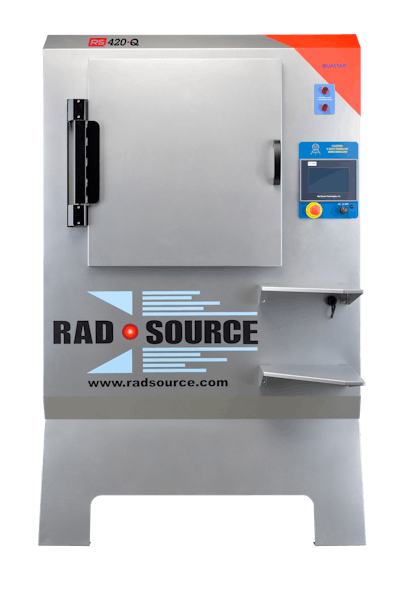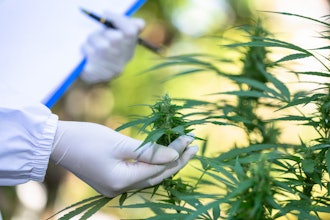
Irradiation has long been used as a safe decontamination method in the food, pharmaceutical and medical implant industries. Still, cannabis operators remain confused over the technology's efficacy, safety and impact on the bottom line. For example, some are led to believe that irradiated cannabis loses its value.
I recently spoke with George Terry, executive vice president at Rad Source, a company that manufactures equipment that uses patented photonic decontamination technology. According to Terry, these systems help operators pass state-mandated testing levels with more than 99% confidence.
 The Rad Source 420 M Cannabis Decontamination System can process one-to-two pounds of product in a three-to-four-hour cycle.Rad Source
The Rad Source 420 M Cannabis Decontamination System can process one-to-two pounds of product in a three-to-four-hour cycle.Rad Source
David Mantey: How does Rad Source's patented photonic decontamination work?
George Terry: Rad Source's technology is the same as what is used for viral inactivation for vaccines and the inactivation of T-Lymphocytes in blood for TA-GVHD [a rare and typically fatal complication of blood transfusion in which lymphocytes from the transfused blood attack the recipient's tissues]. It uses photons to interact with the DNA of the microbial, rendering it non-viable and unable to reproduce.
Mantey: Where is the equipment manufactured?
Terry: The equipment is made in Buford, GA, just north of Atlanta.
Mantey: Is irradiation a safe and effective form of cannabis remediation? Does it pose any risk to the plant, the operator or the consumer?
Terry: Irradiation is safe and effective. In fact, it is GRAS (generally regarded as safe) for prescription medications and is approved and promoted by the FDA for certain food decontamination. There are a few different forms; we use X-ray as opposed to gamma (which is a radioactive isotope and not good for the planet).
X-ray is like a light bulb. Actually, it is a light bulb that emits X-ray photons instead of visible light. Our unit conforms to [the FDA's] CFR 1020.4 for a cabinet x-ray device, so it is safe to operate. Also, it's not the same as traditional X-ray systems that were invented more than 100 years ago; we reinvented it to adjust to a photon characteristic that is unfavorable to microbial viability.
Mantey: How does irradiation compare to other popular forms of cannabis remediation?
Terry: We use the term "decontamination" because remediation means it has been tested and failed. Many of our customers treat their product before testing; therefore, there is no need to remediate. But we remediate too. There is lots of talk about other forms of remediation, but none of them have the ability to make a microbial non-viable, much less de-active aspergillus with minimal impact to look, feel, moisture, terpenes and THC. Only X-ray and gamma have the ability to penetrate through the flower, and the wavelength is smaller than the molecule, so it does not negatively impact the final product.
Mantey: Does irradiation devalue cannabis at all?
Terry: No, and it is required in many places outside the U.S. A majority of prescription drugs, medical implants and such are irradiated. The false rumors of devaluing come from stakeholders of "other" forms of decontamination because they cannot do what we do.
 The Rad Source 420 Q Cannabis Decontamination System can process up to five pounds in a four-to-five-hour cycle.Rad Source
The Rad Source 420 Q Cannabis Decontamination System can process up to five pounds in a four-to-five-hour cycle.Rad Source
Terry: The 420 Series is specifically designed to give dose uniformity at the density of cannabis flower and guarantee an even spread of photons throughout the container so nothing is missed. We are the only ones that claim and can deliver over 99% success for microbials while keeping THC and terpenes intact if used properly.
Mantey: Why is the industry sometimes apprehensive to bring the equipment in house? Is it more the capital expense or misinformation regarding safety?
Terry: Both, but we run an ROI for our prospects, and many of them recapture the expense in a couple months by being able to sell full flower instead of getting 20% on the dollar from going to extract.
Mantey: How does the system compare to other irradiation equipment in the cannabis industry?
Terry: The only real comparison to the effectiveness is gamma, which has been used for over a decade for decontamination at a medical level. Other X-ray units just entering the market are trying to ride on our success, but their technology is different. Our Quastar emitter is a new technology that is similar to gamma, without the isotope, and at a much lower power.
 The Rad Source 420 XL Cannabis Decontamination System can process from 30 to 50 pounds in a five-to-seven-hour cycle.Rad Source
The Rad Source 420 XL Cannabis Decontamination System can process from 30 to 50 pounds in a five-to-seven-hour cycle.Rad Source
Terry: People who think that just because they have a solution that works on almonds or smoky hotel rooms, it will work for cannabis. You have to get the flower to 0 or too few to detect. Otherwise, the microbials continue to grow. Passing at 6000 CFU on a 10,000 CFU limit is temporary; give it a few days [or weeks], and you will not be passing anymore, and somebody is going to get sick.
In addition, there is no legal "organic" cannabis. Since it is federally illegal, there are no certifiers that can certify it as organic. I bring this up because the news is full of people who are hospitalized or die from "organic" products that contain contaminants. Just think to yourself, when have you seen a news article about someone eating a strawberry treated with photons being hospitalized? Microbes are everywhere, and some are dangerous; that's why we are in line with authorities that advocate public safety.























